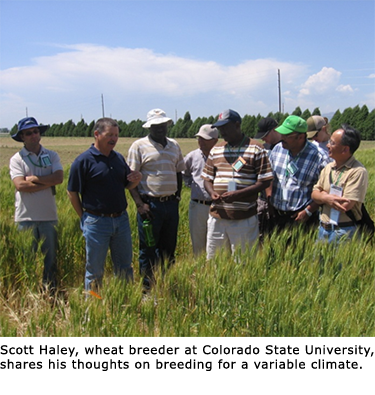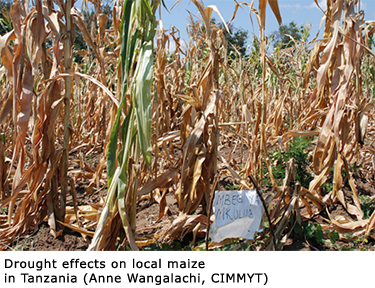Growing Importance of Drought Stress
Moisture deficits are one of the greatest challenges to future crop production. Severe drought in many parts of the world in recent years drastically reduced crop yields and disrupted regional economies. Even in average years, however, many agricultural regions, including the U.S. Great Plains, suffer from chronic moisture deficits. Cereal crops typically attain only about 25% of their potential yield due to the effects of environmental stress, with moisture stress the most important cause. Two major trends will likely increase the frequency and severity of crop moisture deficits:
(1) Global climate change. Higher temperatures will increase crop water use due to increased transpiration. A warmer atmosphere will also speed up melting of mountain snowpack, resulting in less water available for irrigation. More extreme weather patterns are expected to increase the frequency and severity of drought in some regions.
(2) Competing uses for limited water supplies. Increased demand from municipal and industrial users, together with water needed to maintain environmental quality, will further reduce the amount of water available for irrigated crops.
Although changes in tillage and irrigation practices can improve production by conserving water, enhancing the genetic tolerance of crops to drought stress is considered an essential strategy for addressing moisture deficits.
Increasing Need for Plant Breeders
As world population continues to increase and incomes rise, the demand for agricultural products will increase by 50% or more by 2050. Although plant breeding will be a key part of meeting that demand, recent reports in the U.S. and elsewhere have pointed out that too few plant breeders are being educated to fill the available positions.
To be effective, plant breeders of the future will need a combination of knowledge, skills, and experience in plant breeding, genetics, genomics, statistics, experimental design, genetic diversity, and germplasm management (Repinski et al., 2011. Crop Sci. 51:2325–2336). They must be skillful communicators and have the ability to work well in interdisciplinary teams. Given rapid changes in crop science and genetic technology, breeders must continually upgrade their knowledge and skills to stay current.
Addressing Educational Needs
Given the increasing scarcity of water for crop production, it is important that plant breeders understand the physiological mechanisms of drought tolerance and strategies for improving crop productivity under limited moisture. To help meet that need, Colorado State University, assisted by a USDA-NIFA grant, have developed two novel courses and a Symposium offered in alternate years:
1) A distance education course offered in Fall semester of odd-numbered years.
(2) A 2-week field-oriented short course on the genetics, breeding, and physiology of drought stress tolerance, held in summer of even-numbered years.
3) A 2-day Symposium on Plant Breeding for Drought Tolerance, which coincides with the last days of the field-oriented short course.


 This program was initiated by a grant from USDA-NIFA.
This program was initiated by a grant from USDA-NIFA.